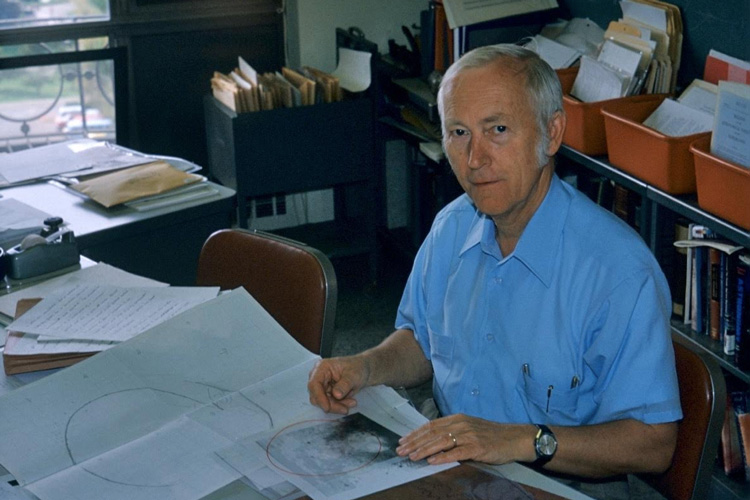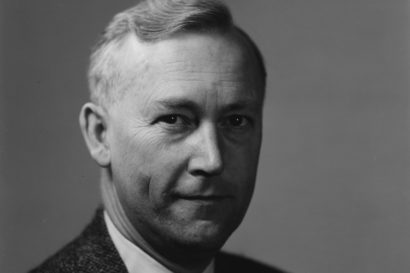Pioneering radio astronomer Harold Weaver dies at age 99
Weaver founded UC Berkeley's Radio Astronomy Laboratory and discovered the first interstellar maser

May 3, 2017
Harold Francis Weaver, a pioneer of radio astronomy who discovered the first microwave laser, or maser, in space, passed away peacefully in his Kensington, California, home on April 26 at the age of 99.
Weaver was a professor emeritus of astronomy, the founder of UC Berkeley’s Radio Astronomy Laboratory and its director from 1958 until 1972 and a former chairman of the Department of Astronomy.
As a young astronomer at the University of California’s Lick Observatory near San Jose, and starting in 1951 as a member of the UC Berkeley astronomy faculty, Weaver became keenly aware of the potential of radio astronomy, which at the time was a young field. Many objects in space give off radio waves, from gas clouds and stars to galaxies, and today astronomers even observe microwave background radiation to infer the early history of the universe shortly after the Big Bang.
After several years of proposal writing, talking to administrators and searching for funds, Weaver founded the Radio Astronomy Laboratory in 1958. Two of his colleagues were Samuel Silver, a professor of electrical engineering and the namesake of the campus’s Space Sciences Laboratory, and Luis Alvarez, a physicist and winner of the 1968 Nobel Prize in Physics.
The lab dedicated its first telescopes, including an 85-foot dish – at the time, one of the world’s largest – in June 1962, in Hat Creek Valley in Northern California, far from radio noise that would have interfered with observations. Using the dish, Weaver and his colleagues discovered the first astrophysical maser – microwave amplification by stimulated emission or radiation, the radio equivalent of a laser – which had only been realized on Earth eight years earlier by the late UC Berkeley physicist and Nobel laureate Charles Townes.
At the time, many astronomers thought molecules could not exist in space, and the radio emissions Weaver recorded were attributed to an unknown form of interstellar matter named “mysterium.” But the emission was soon identified as coming from OH or hydroxyl molecules inside molecular clouds. Since then, many interstellar molecules have been found to emit coherent light in the form of a maser.
For decades, Weaver used the telescope to study other aspects of the interstellar medium and conducted large-scale surveys of interstellar hydrogen. The large telescope he built was destroyed by heavy winds in 1993, by which time Weaver’s successors were building smaller telescopes and assembling them in arrays to obtain even more sensitive measurements of radio emissions from space.
A gifted teacher, he mentored both undergraduate and graduate students, and occasionally taught seminars on archeoastronomy, the study of how ancient civilizations viewed and explained the changing night sky.
“Harold was an outstanding thesis adviser,” said one of Weaver’s former graduate students, Miller Goss, who went on to direct the Very Large Array of the National Radio Astronomy Observatory. “His exacting counsel was invaluable. I learned many lessons that have stayed with me for the past 50 years. As I finished my thesis in early 1967, I will never forget sitting in the living room of the Weavers’ house with scissors as he taught me how to ‘cut and paste’ in a pre-computer manner.”
Among the many astronomers he mentored was Carl Sagan, whom he encouraged to explore his far-out ideas on the beginnings of life in the universe.
Weaver was born Sept. 25, 1917, in San Jose, where he lived with his parents above a spaghetti factory. After high school, as he was deciding whether to study astronomy or classics, Carmel poet Robinson Jeffers befriended him and encouraged his telescope building. Finally deciding to continue with astronomy, he went on to obtain his bachelor’s degree in 1940 and his Ph.D. in 1942 in astronomy from UC Berkeley.
After spending one year as a National Research Council postdoctoral fellow at Yerkes Observatory in Wisconsin, Weaver was conscripted into the war effort, working on optics with the National Defense Research Committee and later on isotope separation at the Berkeley Radiation Lab as part of the Manhattan Project.
As an undergraduate taking a course in practical astronomy, he met his future wife, Cecile Trumpler, daughter of UC Berkeley astronomer Robert Trumpler. They married in 1939, before the elder Trumpler supervised Weaver’s Ph.D. dissertation on peculiar stars, star clusters and stellar statistics based on observations at Mt. Wilson Observatory in Southern California.
After the war, Weaver returned to astronomy as a staff scientist at Lick Observatory from 1945 to 1951, when he joined the Berkeley faculty at a time when the department’s focus was shifting from orbital calculations to stellar astrophysics. In 1953, Weaver and his father-in-law co-authored the book Statistical Astronomy.
Over Weaver’s career, he published more than 70 professional papers. He retired in 1988, but remained very much involved in the department until nearly the end of his life.
“Harold came in every day until he was well into his 90s and was always a welcoming presence,” said Leo Blitz, a professor emeritus of astronomy and former director of the Radio Astronomy Lab. “He was never too busy or removed to talk about science, especially the implications of his groundbreaking survey of interstellar atomic hydrogen.”
“Harold was hidden away in his office in the old Campbell Hall almost daily, trying to map the local Bubble, the low-density region in interstellar space in which our sun and planets are located”, said Imke de Pater, a professor and former chair of astronomy.
Weaver helped guide development of the Berkeley campus as a member and then chair of the Campus Facilities Committee in the 1950s and 60s, helping to design and name the new home of the astronomy department, Campbell Hall. The building was recently demolished and rebuilt on the same site.
“Harold was truly a giant in our Department of Astronomy,” said colleague Alex Filippenko. “I will always remember his warm smile, his generosity and how he kept going with his research and other activities well into old age.”
“Harold was the wise voice of departmental memory – always discreet, yet with biting insight,” said Jon Arons, a professor emeritus and former chair of astronomy. “He was a fascinating source of insight into radio astronomy’s early days, and what the Radio Astronomy Lab meant to the health of the department.”
Weaver served as treasurer of the American Astronomical Society in the 1980s, and as treasurer of the Astronomical Society of the Pacific. He was part of the group that founded the Chabot Space and Science Museum and played an active role on its board for many years.
As a lover of music ranging from Mahler to the Beatles and Dave Brubeck, he also teamed up with David Williams and Tap Lum to found Berkshire Technologies, Inc., a company that made radio receivers that could pick up the faintest sounds. He also applied his interest in statistics to the stock market, working with Victor Nierderhofer on stock market modeling.
In addition to Weaver’s excitement about science, he was known for his kindness and his warm smile, his colleagues said. He and his wife, Cecile, organized numerous social events at their house, a tradition that has been continued by the Radio Astronomy Lab.
He is survived by his wife, three children – Margot of Tucson, Arizona, Paul of Kensington and Kirk of Houston, Texas – six grandchildren and 11 great-grandchildren. He and his wife donated their home in Kensington to the university to be used after their deaths to fund the Trumpler-Weaver Endowed Professorship of Astronomy at UC Berkeley.
A memorial service is being arranged. In lieu of flowers, the family requests that memorial gifts be made to the scholarship fund that enabled Weaver to attend college, the Cal Alumni Leadership Award. Donations should be sent to California Alumni Association, 1 Alumni House, Berkeley, CA 94720.

